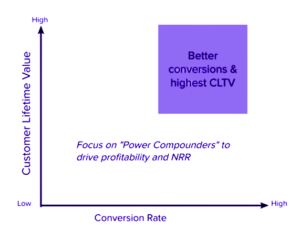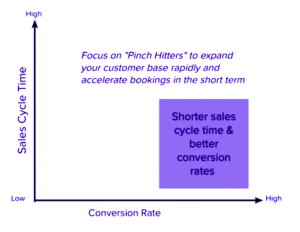As I discussed in my blog post last month scaling beyond founder-led sales can be a daunting step in a Founder’s entrepreneurial journey.
So, if you’ve made it this far and decided to hand off critical responsibilities of your company just as the stakes are rising, then I applaud you. Taking this step is difficult but necessary if you’re going to predictably grow your company in a sustainable way.
Now it’s time to look at how to build your sales funnel into a well-oiled machine while making sure that you, as the founder, don’t become the bottleneck. The sales funnel is deconstructed into three different parts: the top of the funnel (ToFu), the middle of the funnel (MoFu), and the bottom of the funnel (BoFu). Let’s take it from the top.
ToFu: Define Funnel Stages and Policy
Interestingly, the work really begins before any qualified sales lead even enters the funnel. First, the founder needs to clearly define the policy and structure of the funnel for the CRM stack to enable it for meaningful funnel analysis.
Definitions
The Ideal Customer Profile and Personas need to be defined through attributes that can be readily accessed externally for outbound demand generation and captured during the lead journey to support funnel optimization by target segment.
Funnel stages need to be defined, documented, and instrumented in the CRM system. Each stage requires clear exit criteria defined so all team members are on the same page when a contact exits one lifecycle stage and moves to the next.
Marketing Qualified Lead (MQL): Marketing-driven hand raiser (demo request, sales contact request, download of gated content …) that meets minimum requirements or lead score to be declared an MQL. In most cases, the lead score is a mix of profile indicators that demonstrate fit with the ICP and persona definitions as well as a digital behavior score. The stronger the profile fit, the less behavior is needed to justify follow-up. Early stages start-ups might begin with low barriers on the lead score and then make them more stringent over time.
Sales Qualified Lead (SQL): MQL that shows enough intent activity to hit the lead scoring threshold (downloads, page views, website visits, etc) and has been reviewed and accepted by an SDR or an AE. Alternatively, an SQL may be a lead that has been pursued by an outbound prospecting effort and meets ICP and persona requirements and has been vetted for early pain indicators and any tech stack or competition deal breakers.
Sales Accepted Opportunity (SAO): An MQL or SQL that has been reviewed and “accepted” by an AE to be declared a Sales Opportunity. This is usually supported by being the point at which an Opportunity or “Deal Object”, as opposed to a Lead or “Contact”, is created in the CRM system of choice. It is a typical requirement that an AE must be able to record a projected value to the opportunity and a close date in order to be considered an SAO.
Sales Qualified Opportunity (SQO): A SAO that has been rigorously qualified by the AE using a qualification discipline such as MEDDPICC to determine that the opportunity will close within a given period usually the current quarter or current month depending on the cadence of your business. The SQO funnel stage is often supported by underlying sales pipeline stages. The original contact may stay static in the SQO funnel stage while sales is working to qualify the deal on MEDDPICC and increase the probability to win.
Tip: Sales stages should be driven by proof of the urgency of the customer and not be driven purely by activities. For example, you might complete a demo, start a trial or run a business case but if you don’t use those activities or meetings to better qualify the deal, then you are likely to face issues in your forecast predictability.
Won: An opportunity that has become a contractually executed transaction with contracted ARR that will be collected within 12 months based on GAAP principles according to your CFO.
Tip: While it is important to understand each stage and the conversion between stages, you should focus on SAOs as the critical funnel metric. SAOs represent the sales potential to meet your revenue goals. This is your pipeline contribution metric. Obsess over it!
Introducing rigorous definitions will make the handoff from marketing to sales much easier, which will lead to less friction between the two divisions because you’re essentially marking their territories. It’s also helpful so your CRM systems can consistently indicate where a certain lead is in the funnel and its probability to close. This makes conducting a funnel analysis and looking at conversion rates and other key data much easier as well.
Tip: The CRM system must capture when a lead enters and leaves each stage so that conversion rates and stage cycle times can be accurately measured. Remember, leads should only move in one direction in the funnel. For instance, if a contact reaches a new stage and then stalls, you won’t want to move them back to the ToFu and market to them as if they were a completely new lead confusing the prospect and your funnel analytics. Instead, move the lead into a nurture program to re-engage. You can do this by creating statuses in the CRM that help you understand leads at each stage and whether they are active or inactive and need to be nurtured.
Just like you are defining the different stages of the funnel for the entire company, the founder also needs to set clear parameters for what makes a prospect a qualified lead. Oftentimes, this can be done through dealbreaker questions that examine the prospect’s tech stack or what kind of person the sales rep is speaking to (i.e. are they a decision maker?).
You also need to make sure that the people working in the ToFu, most of which will be business development representatives (BDRs) running cold prospecting campaigns, have clear messaging that you created. It’s a big mistake to give BDRs too much freedom, especially in the beginning.
Tip: Keep the messaging tight and only run one or two primary cadence tests. Iterate on those two tests until you find consistent results. After there is consistency and multiple BDRs have found success, then you can get more strategic.
The founder must also create a compensation model that is tied to moving leads from the ToFu to the MoFu. Remember, you want everyone in the funnel to be incentivized to help close deals but you can’t really close a deal in the ToFu.
Ideally, you want 60% to 80% of a BDR’s overall incentive compensation tied to outcomes that they have control over. There can be deal or revenue upside but again you really want the BDR to have a lot of control over the majority of their compensation. In a long sales cycle, BDRs could be waiting months to a year for incentives tied to revenue to hit their paycheck.
The last part of scaling the ToFu should include trying to figure out what messaging is working. Are certain questions or wording getting more responses? Are you finding surprise decision-makers that you might’ve never considered before?
Tip: Eventually, you want your BDRs to be able to test what kind of outreach is working on their own and be able to adjust more seamlessly and on the fly. But until they’ve had some experience keep things as simple as possible.
MoFu: Audit And Assist Sales Reps
So, how do you prepare your new sales team for their first call? The founder needs to create a wireframe, or essentially an outline of how the sales rep should try and steer the call. New sales reps will lack the product, customer, and sometimes even the industry experience of the founder. They will need to operate through memorization to start before they begin customizing their dialogue and adapting on the fly.
Tip: A good wireframe is not word for word but highlights the most important elements to be discussed on each slide of a presentation. Consider it the minimum viable product of the presentation.
It might be frustrating for the founder at first, who knows their company and the sales material so inherently well, but it’s going to take some time for sales reps to find their footing. Founders must be patient but can foster their reps by reviewing their phone calls through conversational artificial intelligence tools such as Gong.io and Chorus.ai.
As I discussed in my previous post, while these tools may seem a little weird at first they are absolutely critical to ensuring reps find the right messaging and improve lead conversion.
Conversational AI tools also allow founders to monitor multiple calls and remove themselves further from the sales process. It is a good idea, however, to have pre-call plans to prepare for these important calls and then use conversational AI to review the actual calls.
Tip: While using conversational AI, do a “what we heard” exercise where you and the rep write out the main points and critical moments from a call and then compare and evaluate the differences.
BoFu: Walking The Line
Now that you’ve made it through ToFu and MoFu, it’s time to drive sustainable revenue in the BoFu. At this point, the bases are loaded and you are trying to bring runners home but that doesn’t mean you have to swing for the fence. Sometimes, a walk or a sacrifice fly is all it takes.
A big thing I touched on in my previous post is how difficult it can be for founders to remove themselves from the early stages of the sales process. But if the founder can successfully do this, they can position themselves as a much more valuable asset in the later stages of the sales process.
At this point, the potential client is clearly very interested but needs to know they can bring their boss something good, or help their company enough to justify the purchase if they are the boss.
You, as the founder, are here to lay out the vision, create a roadmap, and prove to the decisionmaker that they should buy your product. But as the founder, you need to tread carefully in the BoFu. There’s a fine line between being an asset to the sales process that helps close deals quicker and taking it over altogether.
This is what founder involvement should look like in the BoFu:
- Bring customer stories and proof
- Lay out the vision for the company and the roadmap for innovation
- Run a customer demo as a solution engineer or expert
- Address unique needs like integrations or product customizations
- Support negotiation by talking about the business and policies that support growth and innovation
Here are some things the founder should NOT do:
- The founder should not take over the meeting
- The founder should not run the agenda
- The founder should not distract from the opportunity to get deal qualification detail
- The founder should not walk through next steps or step in as the owner of next steps
Your job as the leader is to prepare your troops for battle and make sure they are ready for the final meeting. Founders need to equip their sales team in the BOFU with policies around the ideal deal structure and help them understand why.
Tip: Expectations for term lengths should be clearly communicated, with pricing and cost drivers outlined, and options for negotiation provided to the salesperson with clear guidelines on what can and cannot be approved.
Founders should push to ensure there are practice sessions for big presentations and negotiations:
Tip: These are the most valuable and critical steps and preparation is warranted. Founders should push their teams to take steps to show up prepared to maximize these interactions through mock presentations, presentation strategy, prep meetings, and negotiation role plays.
Finally, founders need to ensure there is a clear customer journey post transaction. What is the ideal path for a customer to take once they become a customer? How do we establish that vision with customers late in the sales process and again during implementation?
Remember, as the captain of your team, you succeed when your teammates succeed and fail when they fail. Once your team starts succeeding and closing deals quicker you’ll see just how valuable your new sales funnel can be.
Subscribe to our newsletter to get more great content like this (once or twice per month).



